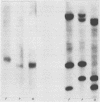Abstract
DNA samples were obtained from children with Wolf-Hirschhorn syndrome and their parents to assist with gene mapping studies of 4p16.3 (the region known to contain the Huntington's disease gene). A panel of seven families was studied, using polymorphic DNA markers, to determine the parental origin of the chromosome abnormality resulting in Wolf-Hirschhorn syndrome. All seven cases were the result of de novo deletions or rearrangements of 4p and in each case the abnormality arose on the paternal chromosome. Analysis of the 3' hypervariable regions of the alpha globin and mucin loci indicated that non-paternity was unlikely to be an explanation for these results. A paternal age effect was not observed. The possibilities of an environmental influence or genetic imprinting require further consideration. This report extends information regarding the preponderance of the paternal origin of de novo structural deletion syndromes.
Full text
PDF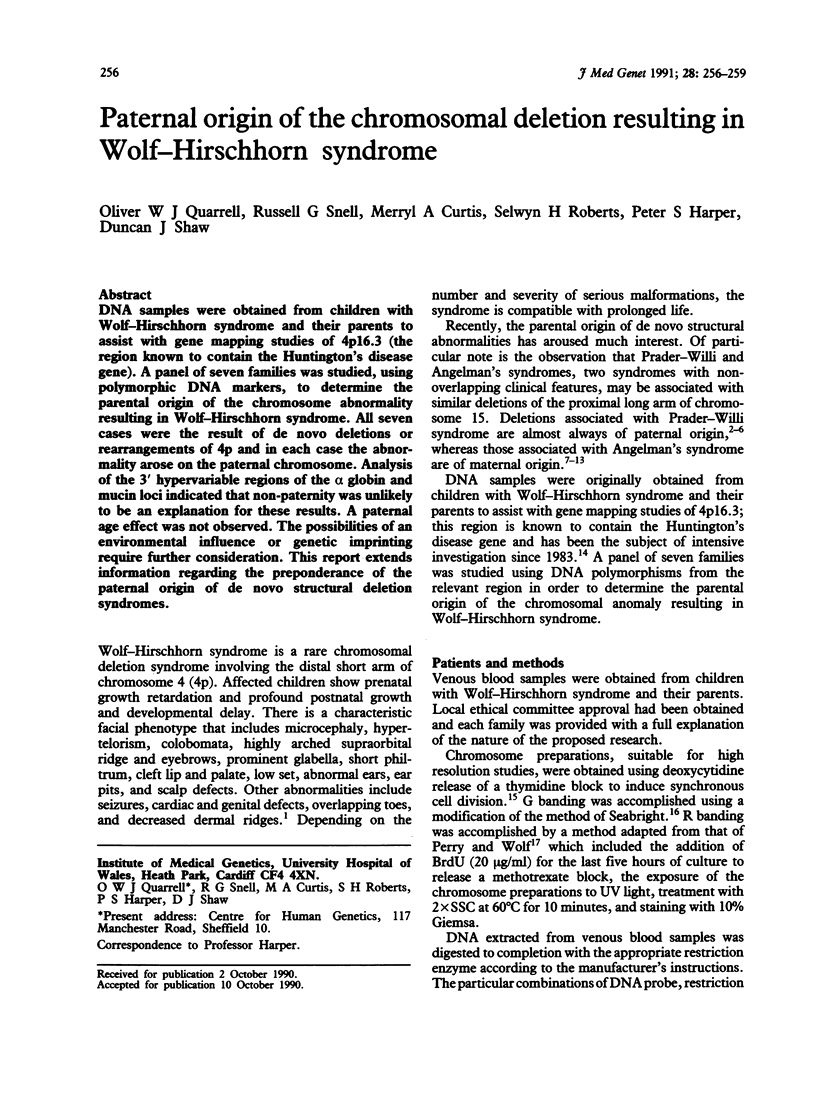
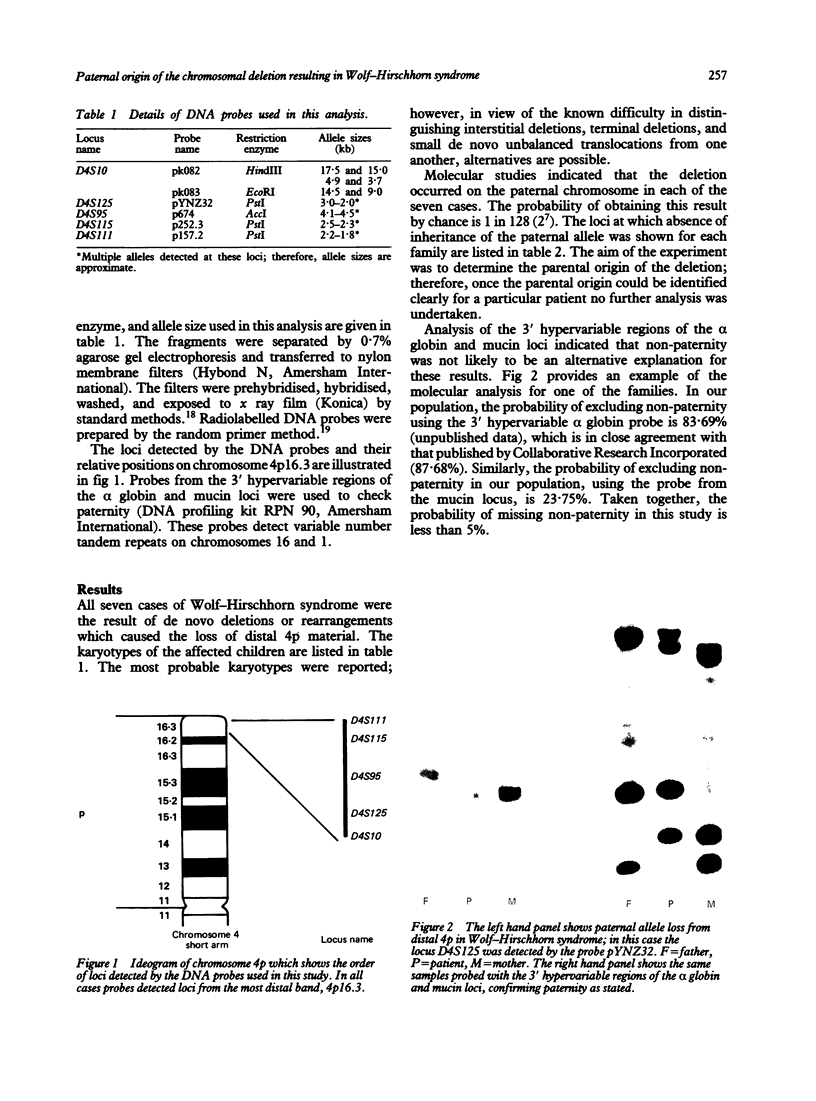
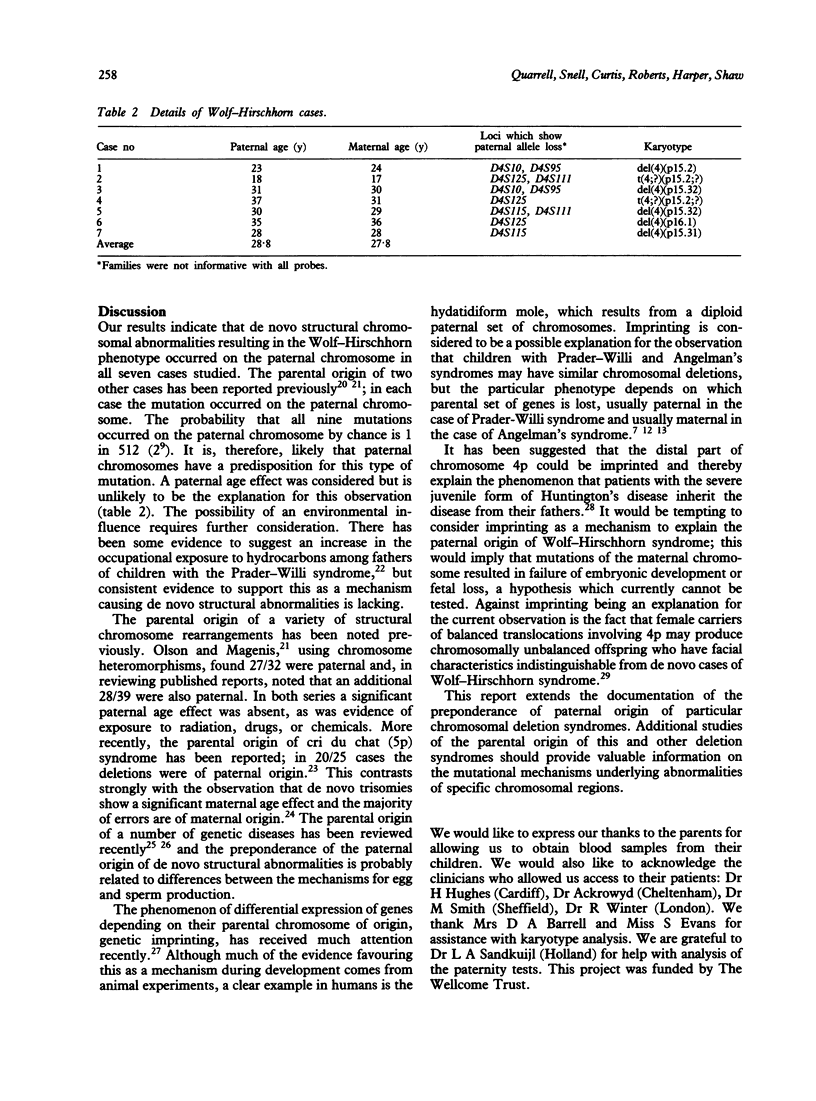
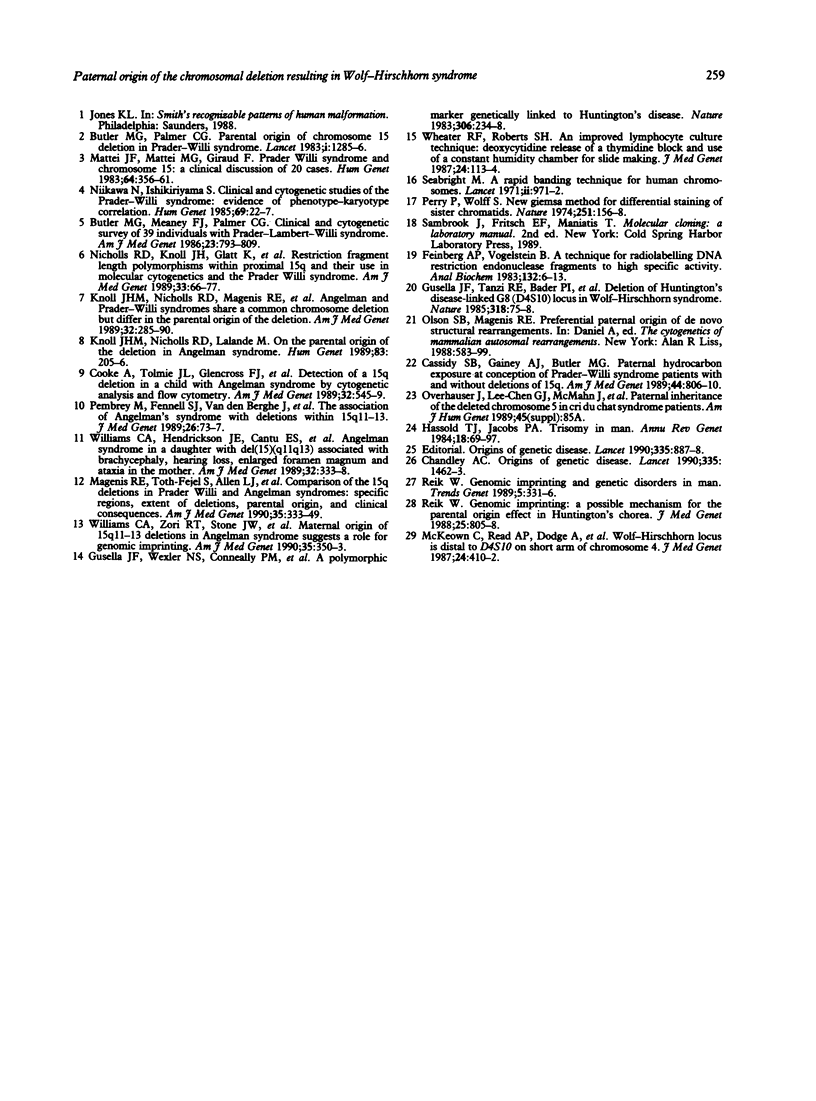
Images in this article
Selected References
These references are in PubMed. This may not be the complete list of references from this article.
- Butler M. G., Meaney F. J., Palmer C. G. Clinical and cytogenetic survey of 39 individuals with Prader-Labhart-Willi syndrome. Am J Med Genet. 1986 Mar;23(3):793–809. doi: 10.1002/ajmg.1320230307. [DOI] [PMC free article] [PubMed] [Google Scholar]
- Butler M. G., Palmer C. G. Parental origin of chromosome 15 deletion in Prader-Willi syndrome. Lancet. 1983 Jun 4;1(8336):1285–1286. doi: 10.1016/s0140-6736(83)92745-9. [DOI] [PMC free article] [PubMed] [Google Scholar]
- Cassidy S. B., Gainey A. J., Butler M. G. Occupational hydrocarbon exposure among fathers of Prader-Willi syndrome patients with and without deletions of 15q. Am J Hum Genet. 1989 Jun;44(6):806–810. [PMC free article] [PubMed] [Google Scholar]
- Chandley A. C. Origins of genetic disease. Lancet. 1990 Jun 16;335(8703):1462–1463. doi: 10.1016/0140-6736(90)91490-2. [DOI] [PubMed] [Google Scholar]
- Cooke A., Tolmie J. L., Glencross F. J., Boyd E., Clarke M. M., Day R., Stephenson J. B., Connor J. M. Detection of a 15q deletion in a child with Angelman syndrome by cytogenetic analysis and flow cytometry. Am J Med Genet. 1989 Apr;32(4):545–549. doi: 10.1002/ajmg.1320320424. [DOI] [PubMed] [Google Scholar]
- Feinberg A. P., Vogelstein B. A technique for radiolabeling DNA restriction endonuclease fragments to high specific activity. Anal Biochem. 1983 Jul 1;132(1):6–13. doi: 10.1016/0003-2697(83)90418-9. [DOI] [PubMed] [Google Scholar]
- Gusella J. F., Tanzi R. E., Bader P. I., Phelan M. C., Stevenson R., Hayden M. R., Hofman K. J., Faryniarz A. G., Gibbons K. Deletion of Huntington's disease-linked G8 (D4S10) locus in Wolf-Hirschhorn syndrome. Nature. 1985 Nov 7;318(6041):75–78. doi: 10.1038/318075a0. [DOI] [PubMed] [Google Scholar]
- Gusella J. F., Wexler N. S., Conneally P. M., Naylor S. L., Anderson M. A., Tanzi R. E., Watkins P. C., Ottina K., Wallace M. R., Sakaguchi A. Y. A polymorphic DNA marker genetically linked to Huntington's disease. Nature. 1983 Nov 17;306(5940):234–238. doi: 10.1038/306234a0. [DOI] [PubMed] [Google Scholar]
- Hassold T. J., Jacobs P. A. Trisomy in man. Annu Rev Genet. 1984;18:69–97. doi: 10.1146/annurev.ge.18.120184.000441. [DOI] [PubMed] [Google Scholar]
- Knoll J. H., Nicholls R. D., Lalande M. On the parental origin of the deletion in Angelman syndrome. Hum Genet. 1989 Sep;83(2):205–207. doi: 10.1007/BF00286723. [DOI] [PubMed] [Google Scholar]
- Knoll J. H., Nicholls R. D., Magenis R. E., Graham J. M., Jr, Lalande M., Latt S. A. Angelman and Prader-Willi syndromes share a common chromosome 15 deletion but differ in parental origin of the deletion. Am J Med Genet. 1989 Feb;32(2):285–290. doi: 10.1002/ajmg.1320320235. [DOI] [PubMed] [Google Scholar]
- Magenis R. E., Toth-Fejel S., Allen L. J., Black M., Brown M. G., Budden S., Cohen R., Friedman J. M., Kalousek D., Zonana J. Comparison of the 15q deletions in Prader-Willi and Angelman syndromes: specific regions, extent of deletions, parental origin, and clinical consequences. Am J Med Genet. 1990 Mar;35(3):333–349. doi: 10.1002/ajmg.1320350307. [DOI] [PubMed] [Google Scholar]
- Mattei J. F., Mattei M. G., Giraud F. Prader-Willi syndrome and chromosome 15. A clinical discussion of 20 cases. Hum Genet. 1983;64(4):356–362. doi: 10.1007/BF00292367. [DOI] [PubMed] [Google Scholar]
- McKeown C., Read A. P., Dodge A., Stecko O., Mercer A., Harris R. Wolf-Hirschhorn locus is distal to D4S10 on short arm of chromosome 4. J Med Genet. 1987 Jul;24(7):410–412. doi: 10.1136/jmg.24.7.410. [DOI] [PMC free article] [PubMed] [Google Scholar]
- Nicholls R. D., Knoll J. H., Glatt K., Hersh J. H., Brewster T. D., Graham J. M., Jr, Wurster-Hill D., Wharton R., Latt S. A. Restriction fragment length polymorphisms within proximal 15q and their use in molecular cytogenetics and the Prader-Willi syndrome. Am J Med Genet. 1989 May;33(1):66–77. doi: 10.1002/ajmg.1320330109. [DOI] [PubMed] [Google Scholar]
- Niikawa N., Ishikiriyama S. Clinical and cytogenetic studies of the Prader-Willi syndrome: evidence of phenotype-karyotype correlation. Hum Genet. 1985;69(1):22–27. doi: 10.1007/BF00295524. [DOI] [PubMed] [Google Scholar]
- Pembrey M., Fennell S. J., van den Berghe J., Fitchett M., Summers D., Butler L., Clarke C., Griffiths M., Thompson E., Super M. The association of Angelman's syndrome with deletions within 15q11-13. J Med Genet. 1989 Feb;26(2):73–77. doi: 10.1136/jmg.26.2.73. [DOI] [PMC free article] [PubMed] [Google Scholar]
- Perry P., Wolff S. New Giemsa method for the differential staining of sister chromatids. Nature. 1974 Sep 13;251(5471):156–158. doi: 10.1038/251156a0. [DOI] [PubMed] [Google Scholar]
- Reik W. Genomic imprinting and genetic disorders in man. Trends Genet. 1989 Oct;5(10):331–336. doi: 10.1016/0168-9525(89)90138-8. [DOI] [PubMed] [Google Scholar]
- Reik W. Genomic imprinting: a possible mechanism for the parental origin effect in Huntington's chorea. J Med Genet. 1988 Dec;25(12):805–808. doi: 10.1136/jmg.25.12.805. [DOI] [PMC free article] [PubMed] [Google Scholar]
- Seabright M. A rapid banding technique for human chromosomes. Lancet. 1971 Oct 30;2(7731):971–972. doi: 10.1016/s0140-6736(71)90287-x. [DOI] [PubMed] [Google Scholar]
- Wheater R. F., Roberts S. H. An improved lymphocyte culture technique: deoxycytidine release of a thymidine block and use of a constant humidity chamber for slide making. J Med Genet. 1987 Feb;24(2):113–114. doi: 10.1136/jmg.24.2.113. [DOI] [PMC free article] [PubMed] [Google Scholar]
- Williams C. A., Hendrickson J. E., Cantú E. S., Donlon T. A. Angelman syndrome in a daughter with del(15) (q11q13) associated with brachycephaly, hearing loss, enlarged foramen magnum, and ataxia in the mother. Am J Med Genet. 1989 Mar;32(3):333–338. doi: 10.1002/ajmg.1320320312. [DOI] [PubMed] [Google Scholar]
- Williams C. A., Zori R. T., Stone J. W., Gray B. A., Cantu E. S., Ostrer H. Maternal origin of 15q11-13 deletions in Angelman syndrome suggests a role for genomic imprinting. Am J Med Genet. 1990 Mar;35(3):350–353. doi: 10.1002/ajmg.1320350308. [DOI] [PubMed] [Google Scholar]



